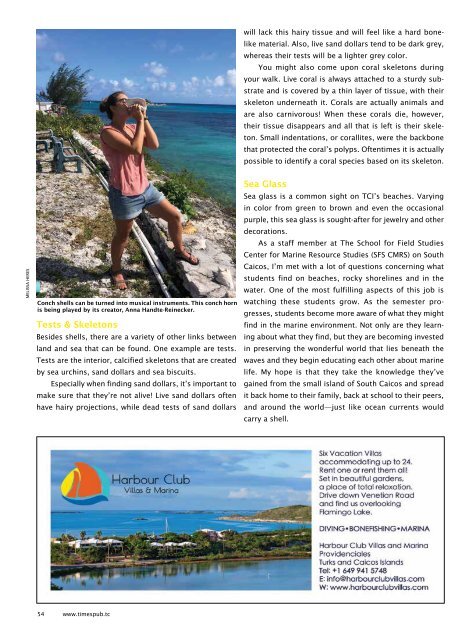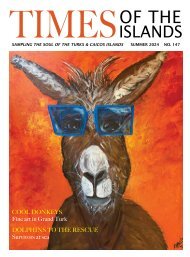Times of the Islands Spring 2021
Presents the "soul of the Turks & Caicos Islands" with in-depth features about local people, culture, history, environment, real estate, businesses, resorts, restaurants and activities.
Presents the "soul of the Turks & Caicos Islands" with in-depth features about local people, culture, history, environment, real estate, businesses, resorts, restaurants and activities.
Create successful ePaper yourself
Turn your PDF publications into a flip-book with our unique Google optimized e-Paper software.
will lack this hairy tissue and will feel like a hard bonelike<br />
material. Also, live sand dollars tend to be dark grey,<br />
whereas <strong>the</strong>ir tests will be a lighter grey color.<br />
You might also come upon coral skeletons during<br />
your walk. Live coral is always attached to a sturdy substrate<br />
and is covered by a thin layer <strong>of</strong> tissue, with <strong>the</strong>ir<br />
skeleton underneath it. Corals are actually animals and<br />
are also carnivorous! When <strong>the</strong>se corals die, however,<br />
<strong>the</strong>ir tissue disappears and all that is left is <strong>the</strong>ir skeleton.<br />
Small indentations, or corallites, were <strong>the</strong> backbone<br />
that protected <strong>the</strong> coral’s polyps. Oftentimes it is actually<br />
possible to identify a coral species based on its skeleton.<br />
MELISSA HERES<br />
Conch shells can be turned into musical instruments. This conch horn<br />
is being played by its creator, Anna Handte-Reinecker.<br />
Tests & Skeletons<br />
Besides shells, <strong>the</strong>re are a variety <strong>of</strong> o<strong>the</strong>r links between<br />
land and sea that can be found. One example are tests.<br />
Tests are <strong>the</strong> interior, calcified skeletons that are created<br />
by sea urchins, sand dollars and sea biscuits.<br />
Especially when finding sand dollars, it’s important to<br />
make sure that <strong>the</strong>y’re not alive! Live sand dollars <strong>of</strong>ten<br />
have hairy projections, while dead tests <strong>of</strong> sand dollars<br />
Sea Glass<br />
Sea glass is a common sight on TCI’s beaches. Varying<br />
in color from green to brown and even <strong>the</strong> occasional<br />
purple, this sea glass is sought-after for jewelry and o<strong>the</strong>r<br />
decorations.<br />
As a staff member at The School for Field Studies<br />
Center for Marine Resource Studies (SFS CMRS) on South<br />
Caicos, I’m met with a lot <strong>of</strong> questions concerning what<br />
students find on beaches, rocky shorelines and in <strong>the</strong><br />
water. One <strong>of</strong> <strong>the</strong> most fulfilling aspects <strong>of</strong> this job is<br />
watching <strong>the</strong>se students grow. As <strong>the</strong> semester progresses,<br />
students become more aware <strong>of</strong> what <strong>the</strong>y might<br />
find in <strong>the</strong> marine environment. Not only are <strong>the</strong>y learning<br />
about what <strong>the</strong>y find, but <strong>the</strong>y are becoming invested<br />
in preserving <strong>the</strong> wonderful world that lies beneath <strong>the</strong><br />
waves and <strong>the</strong>y begin educating each o<strong>the</strong>r about marine<br />
life. My hope is that <strong>the</strong>y take <strong>the</strong> knowledge <strong>the</strong>y’ve<br />
gained from <strong>the</strong> small island <strong>of</strong> South Caicos and spread<br />
it back home to <strong>the</strong>ir family, back at school to <strong>the</strong>ir peers,<br />
and around <strong>the</strong> world—just like ocean currents would<br />
carry a shell.<br />
54 www.timespub.tc

















